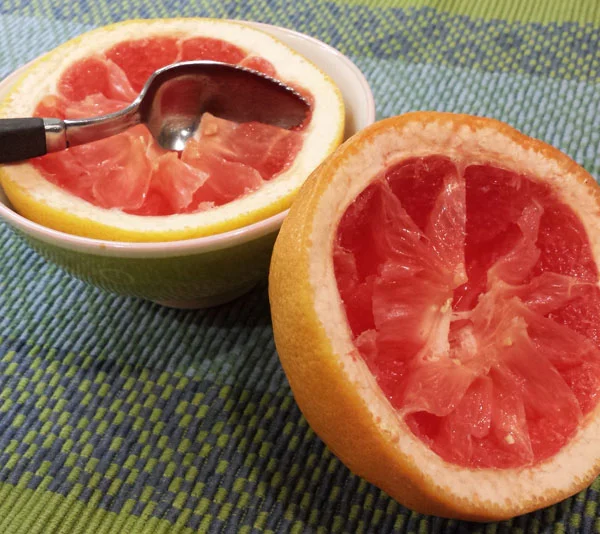Grapefruit Season: My Husband’s Favorite Time of Year
The dead of winter is alive with citrus. It is sweet and juicy, being picked at the peak of ripeness. The simplest thing to do is just eat it. But if you want to take citrus a bit further and stretch your dollar a bit more, consider saving the peel and making it into candy.
I triumphantly walk in our front door on a sunny January Saturday morning, loaded with grocery bags. I stride through the living room past my husband Tom, who is sitting on the couch, and into the kitchen. I immediately rummage through my shopping bags to find my prize. Walking back into the living room, I proudly hold up the bag of grapefruits for Tom to see. He giggles with glee. Yes, we will eat these grapefruits for breakfast and lunch over the next few days, but what makes my husband giddy is the peel. It’s the time of year when I make grapefruit peel candy.
Why it pays to cut kitchen waste
I really do adore using obscure parts of fruits and vegetables (like peel) because I’m a bit of a fanatic about food waste. I vividly remember the day I learned how to use carrot tops to make soup. I smile every time I repurpose the ugly, flappy dirt-stained ends of a bunch of celery when I make broth. But it isn’t just fanatics like me who benefit from minimizing food waste. Some estimate that we waste about $160 billion of food per year in the U.S1. That represents an astounding 31% of the food that we produce. If we could somehow send that food to those that don’t always get enough to eat, we could fill the bellies of 17.4 million families. Of that food waste, 21% comes directly out of our kitchens1. So if we want to save money on feeding ourselves, figuring out how to cut down what we throw out is indispensible.
But citrus peel is over-the-top-gold-star food waste material. I might grate the outside for a recipe or two, but using the whole peel? Now that’s conservation.
The citrus season
January and February is when U.S. citrus comes into season and is thus at its peak quality and nutrition. Even though I’ve known this for years, it still feels strange to walk into a grocery store in January and find superb fruit on the offer. What a bright spot in the middle of winter when much of the other fruit tastes disappointingly flat and mealy because it’s from Australia or Chile. It’s an excellent time to combine grains with citrus to make simple, bright, citrusy winter salads (as in this delicious and easy recipe by Kate Sherwood). I find Moroccan and Middle Eastern stews which feature citrus are particularly good for January when I want to do nothing else but use the slow cooker.
One part of the citrus season is special in our region. Around mid-January, the organic grapefruits from Texas come into our local grocery stores. I start looking right after New Year. Here in Colorado, they are closer to their peak of ripeness than those that travel further from California. They have beautiful variation of skin color from yellow to orange-red, and when you slice them open, the skin is thick with juicy red flesh. If you live in a state bordering Texas you’ll certainly be able to find these beauties. If you are lucky enough to live in a state like Texas or Arizona or California, you might have ripe grapefruit weighing down your trees about this time and be wondering what to do with them.
Turning grapefruit into candy
Organic is important to me because in this case, I’m going to actually eat the peel. I feel very comfortable buying conventional citrus if organic isn’t available or very expensive, because usually, I am peeling the skin and composting it. Pesticides are sprayed on fruit trees, so it’s logical that the highest concentrations of pesticides are on or just inside the skin. That being said, grapefruit just makes it onto the Environmental Working Group’s “clean fifteen” list of fruits and vegetables. This is produce, based on USDA testing, this is the least likely to have pesticide residues after you wash it. So if you can’t find organic grapefruits, using conventional is not much of a gamble.
My mother in law introduced me to this recipe in Homemade Candy by Nell B. Nichols. It’s almost old enough to call it vintage! But you’ll find similar recipes elsewhere on the internet.
- Buy four grapefruit and eat them for breakfast (don’t peel them—the skin will be destroyed—cut them in half instead). Save the skin in the refrigerator.
- Cut the half skins in half again to make quarters and remove the remaining pulp. Put the peel in a bowl and cover with cold water. Weight the peel with a plate or two so that they are submerged. Let stand overnight.
- Drain the peel and cut into ¼ inch wide strips.
- In a saucepan, cover the peel with cold water and slowly bring to a simmer. Remove from heat, cover and let stand about 1 hour. Drain and repeat this process until the peel is no longer very bitter—trust your taste buds. I generally do this process 4-5 times.
- Return the peel to the sauce pan and cover with water again. Boil until the peel is tender, about 15 minutes. Drain well in a colander—pressing out the extra water.
- Pack the peel into a measuring cup (a large 4-cup measure works great) to determine how much you have. Return the peel to the saucepan and pour in 1 cup of sugar for each cup of peel.
The cooked peel will be fully translucent.
- Cook the peel over med-low heat. This part makes me a little anxious every time because it feels like I am going to burn the sugar. Just keep scraping the sugar off the bottom of the pot as the best you can. Eventually the peel will release enough water to form a syrup. Once the syrup forms, the peel will have a dark pith mantled by a glowing orange or yellow peel.
- Turn heat to low and keep cooking, stirring frequently. Keep digging down to bring the bottom peel to the top in order to evenly cook it. Continue cooking until the peel is completely transparent, even the outer part of the peel. This may take a while, so tap into your patience—if not cooked enough, the peel will be unpleasantly chewy. At this point, most of the sugar syrup will have boiled away.
- Drain in a colander, but over something to catch the syrup! A pie plate works well. Save this syrup to use in mixed drinks or for sweetening savory dishes where a touch of citrus would be nice.
- Line a couple of baking sheets with parchment paper and sprinkle lightly with sugar. Separate the pieces of peel on the sheets and allow to stand until pieces are fairly dry—12-24 hours.
- Sprinkle with enough sugar to give the candy a crystalline look. Turbinado sugar is hip, but standard granulated white sugar works best to evenly coat the peel so it’s less sticky. Stir it around with your hands to ensure an even coat.
- Store in a plastic bag, and if keeping for a while, put it in the fridge. Makes 4 cups.
You can also use this same procedure to candy lemon, orange or lime peel. Organic lemons can be hard to find, but I did find a bag at Costco this year with nice, thick skins and made it for the first time. The taste is delicious. The skin of lemons and limes are generally thinner than grapefruit so the result is a harder candy without that pop surprise of juiciness in the center.
Is this candy healthy?
Not exactly. After all, it’s candy. It has plenty of added sugar. Five pieces have 3.75 tsp. of sugar, almost 1/3 of the maximum you should have each day2. But they have a strong enough taste that I find them hard to binge on, so for me they are a good sweet to have around. Unfortunately, the boiling and straining process robs the peel of its more mobile nutritional elements, like vitamin C, which is water-soluble, and the essential oils which are driven out by the heating. But then there’s fiber. Five pieces of the candy have 1.5 g of fiber. That’s about the amount found in a half tablespoon of high fiber seed like flax, and ½ to ¾ as much as in a slice of 100% whole wheat bread. Not too bad for candy.
And it’s dirt cheap. The peel is essentially free, because I would probably compost it otherwise. Five pieces cost $0.02. Twelve pieces, approximately the volume of a Milky Way bar, cost $0.05, and at my local super market a standard size Milky Way bar costs $1.00. Of course if you really need the chocolate (and I do sometimes), you’re out of luck (unless you dip the peel in dark chocolate…mmmm….may be a good idea). But I can’t keep myself away from Milky Way bars if they are in my house, so I prefer the peel. Plus, the peel has 360% of the fiber, 25% of the calories and 48% of the sugar than in the Milky Way.
The bottom line: if you are going to eat candy, eat candied peel. Personally though, I’m glad there’s a peak citrus season only once per year. The anticipation of that gleeful look on Tom’s face when he sees the big bag of grapefruits makes the candy even sweeter.
* Note: Grapefruit may interfere with the action of some medications. If your doctor tells you not to eat grapefruit, don’t eat the peel either.
References
1 Wilson, N. L. W., Rickard, B. J., Saputo, R. and Ho, S., 2017, Food waste: the role of date labels, package size, and product category, Food Quality and Preference, v. 55, p. 35-44.
2 Nestle, M., 2006, What to Eat, North Point Press, New York, New York, 611 p.











